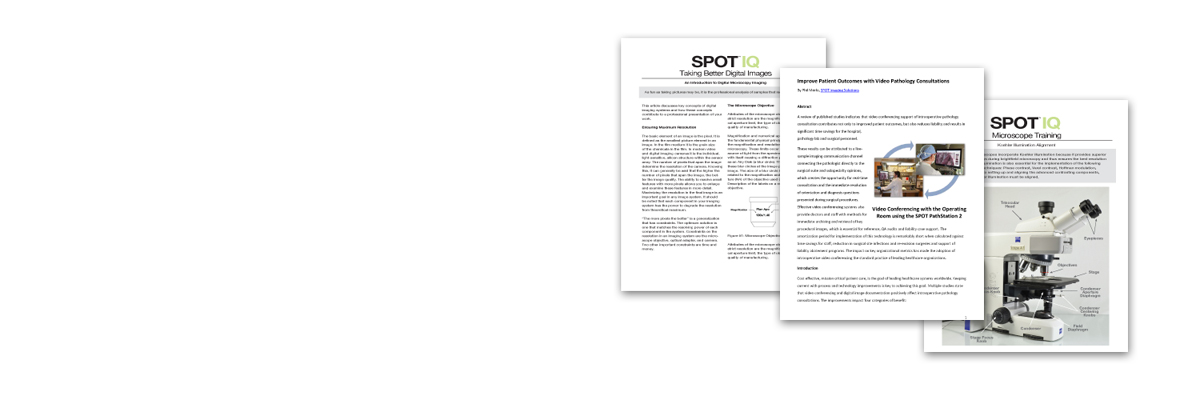Consumer Digital Cameras for Microscopy Imaging
We have all seen the recent improvements in consumer digital cameras. They have gone from low resolution, curiosities to very capable, high resolution, point and shoot cameras. The prices have dropped dramatically making them even more enticing. Do these cameras have a place in pathology? Yes and no, it depends on your intended use.
Lets look at the advantages of the new crop of consumer cameras. The resolution of these new cameras is typically 2 to 5 megapixels. They are portable and can take pictures while not attached to a computer. Their prices are low, ranging from $300 to $1,500 and you can get them through any catalog or electronics store. Why would anyone want to buy a scientific grade camera when these economical choices are available? Lets review these features in more detail and see how they apply to the pathologist.
Resolution
If your intended use is for microscopy, the microscope optics may be the limit to your system’s resolution. Depending on the grade and magnification of your objectives, the resolving power of the system can vary.
| Plan Acromats | Plan Flourites | Plan Apocromats | |||||||||
|---|---|---|---|---|---|---|---|---|---|---|---|
| Mag. | NA | Columns | Rows | Mag. | NA | Columns. | Rows | Mag. | NA | Columns | Rows |
| 4 | 0.10 | 1364 | 909 | 4 | 0.15 | 2045 | 1364 | 4 | 0.20 | 2727 | 1818 |
| 10 | 0.25 | 1364 | 909 | 10 | 0.35 | 1909 | 1273 | 10 | 0.45 | 2455 | 1636 |
| 20 | 0.40 | 1091 | 727 | 20 | 0.55 | 1500 | 1000 | 20 | 0.75 | 2045 | 1364 |
| 40 | 0.65 | 886 | 591 | 40 | 0.85 | 1159 | 773 | 40 | 1.00 | 1364 | 909 |
| 60 | 0.80 | 727 | 485 | 60 | 0.95 | 864 | 576 | 60 | 1.40 | 1273 | 848 |
| 100 | 1.20 | 655 | 436 | 100 | 1.30 | 709 | 473 | 100 | 1.40 | 764 | 509 |
At this point you need to determine what you are using each magnification for. Typically, low magnification objectives are used for gross morphology that does not require higher resolution. Further, the low power objectives do not have adequate numerical aperture to fulfill the requirements of high resolution provided by the high magnification objectives. Therefore, the maximum resolution that you require for your work should be a deciding factor when purchasing a camera.
Resolution affects your image storage capacity and the time required for image manipulation. The larger the file the larger the storage requirements. This is not just a linear relationship, doubling the linear number of rows and columns in an image quadruples the file size (This is an area calculation: rows x columns = area). This can be taxing on your storage capacity and if this resolution does not benefit you in any way, it just fills your hard drive. For example, a 5 megapixel camera produces a 15 megabyte 24 bit RGB file and 1 Gigabyte of storage can only accommodate 66 of these images. Working with large files should also be considered. The time needed to open an image over a network, manipulate the image in an application and then save the image back out, all increase as the square of the linear resolution. Trying these operations out on your computer equipment is an important test to see if the resolution benefit is worth the time and storage space.
System Cost
Lets look at the system cost for putting a consumer camera on a microscope. A 2 to 3 megapixel camera costs in the range of $300 to $600, add charger, spare battery and larger memory card for $100, A card reader for the memory card- $100, a quality optical coupler to attach it to your microscope runs $480-$680, then software to manipulate your images $600 (Adobe PhotoShop) – $1500 (Media Cybernetics ImagePro Express). These systems would then range from $1,580 to $2,980.
The typical system cost for a scientific camera would be as follows: Camera $4,000-$8,000, Coupler $80 – $300, Software $0- $1,500, resulting in a range of $4,080 to $9,800. When considering the purchase price, the consumer camera seems like the economical choice, but this does not take into account the cost of using the camera.
Ease of Use
Have you tried focusing and framing your specimens with the consumer cameras? The small LCD screens greatly limit your ability to visualize what you are capturing (especially if the LCD screen is located on the back of the camera). Changing settings on the camera may entail removing the camera from the microscope and running through the menus on the LCD screen. To transfer images to the computer requires unplugging the memory card from the camera and plugging it into the computer and then reading it. The other method of transferring images requires turning off the camera and connecting the transfer cable then restarting the camera and going into dump mode (many cameras won’t acquire images while tethered to the computer). Often, after all this, you realize the image is not quite what you wanted. The process then starts all over, unplug, turn off camera, plug card into camera, turn on camera, get back into mode you want, frame and focus, capture image, turn off camera, remove memory card, plug into computer, load into application program and view. Time quickly slips by.
The scientific cameras are setup to allow real time viewing right on your computer screen. Focusing, framing, image adjustment, and near instantaneous image acquisition provide a quick, reliable and productive system to work with. Most software packages include powerful features such as auto white balance, auto exposure, image enhancement, annotation, calibration mark and measurement tools. Packages may also incorporate presentation modes, sequential imaging, image notation, image archiving, report generation, print layout tools, and image compression options. A scientific camera that can capture multiple GOOD images per minute, easily out performs the consumer camera with its cumbersome interface, that can only capture multiple images per hour.
How much is your time worth?
Example : 48 images to document
Consumer Camera: 1 image per 10 minute = 6 images /hour
48 /6 = 8 hours work
Scientific Camera : 1 image per 2 minutes = 30 images / hour
48 / 30 = 1.60 hours work
Savings: 8 hours – 1.60 hours = 6.40 hours x $ 50 / hour = $ 320/Day
4 days per week x $ 320/ day = $ 1280 week
Maximum Weeks until break even:
$9,800 — $1,580 = $8,220/ $1,280 = 6 .4 weeks
It only takes a month and a half to make up the purchase price difference.
Support
One last point that should be considered is the fact that the scientific cameras are supported by your local microscope dealer. These are imaging professionals that provide technical support for the scientific cameras but not for the consumer cameras. Getting setup and capturing images quickly the first time can be invaluable.
In summary, don’t be dazzled by the resolution numbers and the low up front price of consumer cameras. They are great for general point and shoot “picture taking” but when it comes to the specialized needs of the pathologist, one must purchase a camera that addresses the actual resolution requirements, while not compromising the productivity of the pathologist.

